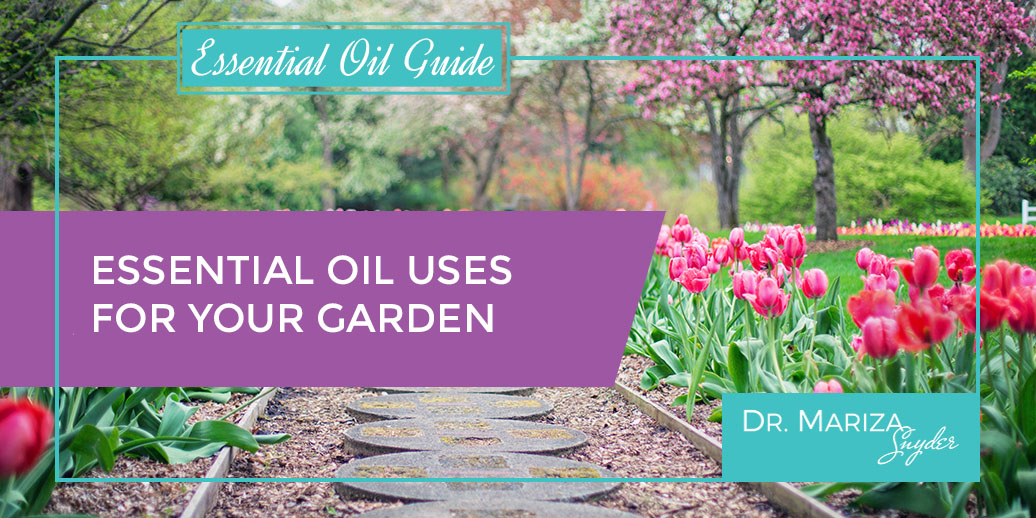
Spring calls for all sorts of new beginnings in our lives, but none more prominent than the renewal of nature all around us. Look high and you see birds busily building their nests while down low sprouts burst out from the ground craving sunlight. While we prepare our bodies for the seasonal changes, many gardeners prep their green world for the growing season. And while organic and natural growing methods seem to be the preference, many of us have not even considered essential oils as a part of our gardening regimen. So, sit back and let the sunshine in while we take a tour through an essential-oil enhanced garden!
METHODS
Though it may seem strange to even consider “applying” essential oils in the garden, there are several successful ways to get the aromas working to your benefit. Try one or a combination of several depending on your needs, or look for the suggestions in the information below. The scents should last a few weeks by masking the pheromones of the plants and confusing the predators. Spray in the early morning hours near the plants and surrounding areas as a preventative method.
- Water + Oil Spray – Simply combine the recommended EO with distilled water and spritz around the area, in the soil or mulch, or directly on the plants when appropriate.
- Soaking Method – In a bowl of distilled water, whisk in several drops of EOs and then soak cottonballs, string, or strips of old fabric. Remove and hang around areas where you want to either attract or repel. You can also bury them in the soil or create a barrier around the garden.
- Diffusers – Either use a diffuser while you are outside to monitor it, or diffuse by placing a drop on lava rocks in the shade.
TERRASHIELD® OUTDOOR BLEND
For those of you not in tick-filled areas, you can rely on the specially-formulated TerraShield® Outdoor Blend from dōTERRA to protect you. Diffuse it, apply it, spritz it…USE IT! Take it with you everywhere from camping trips to hikes to simply playing outside. It protects against environmental pests and keeps you happy during the warm seasons. But in case it isn’t protecting you enough, you can always add some Peppermint to the mix and create your own special blend.
And while we’re talking about dōTERRA blends, you can also find some success with diffusing Purify® Cleansing Blend to keep the bugs away due to its citronella content. I wouldn’t apply this directly to the skin because it is made from several citrus oils, but as far as protection of your home and air, this can be a quick way to create a shield around your environment. (And you can always add some Peppermint to this as well!)
PEPPERMINT WONDER
As mentioned in BUG OFF THIS SPRING, Peppermint essential oil repels just about everything from the tiniest gnat to the larger vermin that may attempt to attack your greenery. When in doubt, go with Peppermint. I would begin by planting Peppermint or another mint variety in pots or directly in your garden if it doesn’t interfere with what you’re trying to grow, and let the natural scent protect the area. Since essential oils are 50-70% more powerful than their herbal counterparts, using high-quality peppermint will amp up the volume of the aroma shield you create around any given area. Use the spray or soak method to surround your area with a minty guard. For vermin, soak the cotton balls and plug the entrances to their holes.
ATTRACTING POLLINATORS
Though I’m sure you expected me to begin with repelling insects, I want to focus on the harmony you can create by using high-quality essential oils. By simply planting or using aromas, you can attract bees and butterflies to your garden. Here is a list of complementary scents and pollinators:
Bees – Coriander, Lavender, Marjoram, Helichrysum, Basil, Sage, Rosemary, Hyssop
Butterflies – Lavender, Fennel, Helichrysum, Sage
REPELLING PESTS
Everyone desires natural methods to keep pesky critters away from their bounty. From neighborhood pets to creepy-crawlies of all sorts, essential oils can be your natural repellent solution to allow your garden to grow. Check out this list below of my favorite essential oils for protecting your crop and lovelies.
Black Pepper(spray mulch or use the soak method)
- Dogs
- Large Mammals
Cedarwood
- Chiggers
- Cutworm
- Roaches
- Slugs
- Snails
- Weevils
Clove
- Flying insects
Rosemary
- Cats (spray in mulch or use the soak method)
- Flies
- Fleas
- Insect Larvae
- Mosquitoes
Thyme
- Biting insects (chiggers, ticks, and roaches)
Peppermint
- Just about everything!
- Aphids
- Ants
- Beetles
- Caterpillars
- Fleas
- Flies
- Gnats
- Lice
- Mosquitoes
- Moth
- Spiders
- Squash Bugs
- Ticks
White Fir (mix with water and ring around plants)
- Slugs
- Snails
FIGHT THE FUNGUS
With fungus causing 85% of plant diseases , it stands that gardeners would do all that they could to prevent it. However, being able to do this and still keep harmful chemicals away from your plants causes a dilemma. Fortunately, high-quality essential oils can be the solution you’ve been hoping for. Not only can they help to prevent fungus from starting, but they can also kill it once it starts!
Melaleuca Essential Oil, also commonly known as Tea Tree Oil, gives you the best chance against fungal destruction. Simply mix about 20-25 drops with 1 cup of distilled water in a glass spray bottle and apply directly to affected plants. Spray in the morning before the plants are under direct sunlight, as the oils will react to the sun’s rays and could damage your plants.
For an All-Around Fungal Preventative, mix 8-10 drops of Melaleuca with your choice of Clove, Cinnamon, Oregano, Peppermint, Rosemary, or Thyme and fill the rest of the glass spray bottle with distilled water. Spray around your plants to prevent fungal growth.
You can also use the string-soaking method, and add 10 drops each Melaleuca and Lavender to a liter of water and then add them around your plants in the soil for extra-added protection.
NATURAL WEED KILLER
Though this isn’t an essential oil solution, I have to share you my secret weapon against weeds – VINEGAR AND SALT! Mix about ½ cup of Kosher Salt in a gallon jug of Vinegar, shake, and apply to weeds. Watch them shrivel up into nothingness and never return! You can add some CASTILE SOAP to the mix for those hard-to-kill buggers in your area.
PLANT-EO COMPANIONSHIP
Did you know that using essential oils in the water that you give to your plants enhances their growth? But not just any essential oil. Science has proven that pairing the right high-quality essential oil can protect and enhance your plant’s growth beyond what you may have imagined! The best way to accomplish this is by adding 6 drops of high-quality essential oils to 2 gallons of warm water, and then letting it cool. Then add another 2 gallons of cold water on top and water as usual. Try these proven natural companions for amazing results:
Basil– asparagus, green beans, broccoli, potatoes, roses, tomatoes
Lavender – apples, grapes, green beans
Geranium – peas
Peppermint – cabbage
Roman Chamomile – onion
Sage – cabbage, carrots, cauliflower, cucumbers, potatoes
Thyme – broccoli, cabbage
GARDENER SUPPORT
Of course, we can’t forget you, the gardener, with your aching green thumb, throbbing back, and tired knees, riddled with bug bites and stings, skin burning from excess sun exposure. Kidding…exaggeration, I know, but we have to keep you in tip-top condition so that you can tend to your impending harvest or beautiful display. Here are some of my favorite essential oil solutions for gardener support:
Lavender – destress from a hard day’s work or apply to skin irritations from rubbing up against the wrong plant, or being stung or bitten.
LLP (Lavender + Lemon + Peppermint) – for support against seasonal respiratory discomfort, apply before and after gardening behind the ears or to the bottoms of your feet. Or opt for dōTERRA TriEase® Softgels for a quick and easy solution that supports you throughout the day.
2 Lavender + 2 Roman Chamomile + 1 Basil in 1 tsp. Apple Cider Vinegar will also take the sting out of insect attacks. Dab on the affected area and relax!
dōTERRA Deep Blue® Rub – massage into your back or aching knees for tingly relief and sustained support from gardening side effects
And how about an amaaaazing DIY recipe for the ultimate in hand-cleansing, exfoliating, and softening after a day with your hands in the dirt?
DIY SUGAR SCRUB FOR GREEN THUMBS
Ingredients:
½ c. Castile soap
½ c. organic coconut oil
1 ½ – 2 cups white sugar
1 tsp. Vitamin E or Sweet Almond Oil
Zest of one Lemon
5-10 drops Melaleuca Essential Oil
5-10 drops Peppermint Essential Oil
(You can add dried herbs or flowers for texture and scent, or switch the EOs for a different aroma – I also like Rosemary, Lavender, and Geranium with the minty tingle from Peppermint.)
Directions:
Mix the soap, sugar, coconut oil, and Vit. E/Sweet Almond Oil well in a glass container. Add the essential oils and continue to mix until well-combined. Store with a lid, and keep close to your nearest post-gardening sink location. If I remember, I like to unscrew the lid and stick a spoon in it before I go out so that, when I return to wash, I can just pick up the spoon and dump into my hand without contaminating the jar.
NATURAL PROTECTION AND SUPPORT
Whatever essential oils you choose to use, you can be assured that you will be giving returning the gift of nature’s essence right back to your garden as it creates new life. The myriad uses for essential oils never cease to amaze me! Keep the spring in your Spring-time gardening extravaganza by enhancing your repertoire with high-quality essential oils. And be sure to let us know if you have any tips or tricks of your own for using essential oils in your garden!
Don’t be a victim of your environment. Heal your body from the inside out and the outside in with essential oils!



So much great information! Thank you – I’m a master gardener and I love to share this kind of information with my friends. Pesticides need not apply 🙂
This is fabulous. Looking forward to using in my gardens. Thanks.